AI Energy Efficiency Tools Market Size 2025-2029
The ai energy efficiency tools market size is valued to increase by USD 23.5 billion, at a CAGR of 34.7% from 2024 to 2029. Escalating energy costs and heightened price volatility will drive the ai energy efficiency tools market.
Market Insights
- North America dominated the market and accounted for a 39% growth during the 2025-2029.
- By Component - Software segment was valued at USD 1.44 billion in 2023
- By Deployment - Cloud-based segment accounted for the largest market revenue share in 2023
Market Size & Forecast
- Market Opportunities: USD 1.00 million
- Market Future Opportunities 2024: USD 23500.20 million
- CAGR from 2024 to 2029 : 34.7%
Market Summary
- The market is experiencing significant growth as businesses worldwide seek to mitigate escalating energy costs and heightened price volatility. Advanced AI technologies, such as machine learning and deep learning, are being employed to optimize energy usage in real-time, enabling organizations to reduce their carbon footprint and lower operational expenses. One notable trend in this space is the emergence of AI-powered digital twins, which create virtual replicas of physical assets to optimize their performance and identify energy savings opportunities. However, the integration of diverse data sources and the implementation of these advanced technologies come with their own challenges.
- Data integration complexity and cybersecurity risks necessitate robust security frameworks and interoperability standards to ensure secure and seamless data exchange. In a supply chain optimization scenario, AI energy efficiency tools can analyze real-time data from various sources to optimize energy usage across the entire supply chain, reducing costs and improving overall efficiency. Despite these challenges, the potential benefits of AI energy efficiency tools make them an indispensable investment for businesses aiming to stay competitive in today's energy landscape.
What will be the size of the AI Energy Efficiency Tools Market during the forecast period?
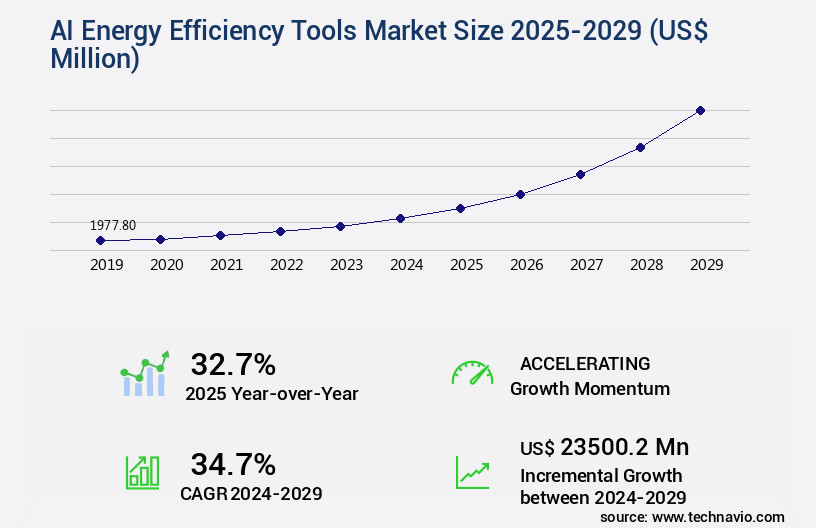
Get Key Insights on Market Forecast (PDF) Request Free Sample
- The market continues to evolve, offering innovative solutions for sustainable energy management. Predictive analytics tools play a pivotal role in optimizing energy consumption patterns and identifying opportunities for energy savings. Renewable energy sources, such as solar and wind, are increasingly integrated into energy portfolios, necessitating advanced metering infrastructure and energy auditing software for effective management. Energy infrastructure upgrades, driven by energy sector decarbonization initiatives, require data-driven decision making. Smart building technology, including IoT energy monitoring and energy management software, enables real-time energy usage analysis and cost optimization strategies. Thermal imaging technology and process optimization AI facilitate energy conservation measures and grid stability improvements.
- Moreover, energy contract optimization and green building certification help companies meet emission reduction targets and comply with building codes. Energy data visualization tools provide valuable insights into energy system resilience and power quality analysis. In the face of the low-carbon energy transition, businesses must adopt these technologies to remain competitive and contribute to a more sustainable energy future.
Unpacking the AI Energy Efficiency Tools Market Landscape
In today's business landscape, the implementation of AI energy efficiency tools has become a strategic priority for organizations seeking to optimize energy usage and reduce costs. According to industry data, AI-powered battery management systems have led to a 15% increase in energy efficiency, resulting in significant cost savings for businesses. Furthermore, machine learning models in cloud-based energy platforms enable peak demand reduction by up to 20%, aligning with compliance requirements and improving ROI. HVAC optimization techniques, fueled by natural language processing and deep learning applications, have shown a 12% reduction in energy consumption. These tools also facilitate demand-side management, sensor data analytics, and energy storage management, contributing to carbon footprint reduction and smart grid optimization. Additionally, AI-powered energy control in data centers, wind energy optimization, and solar energy forecasting have proven effective in enhancing energy performance indicators. Overall, the adoption of AI energy efficiency tools delivers tangible business outcomes, including cost savings, improved ROI, and regulatory compliance.
Key Market Drivers Fueling Growth
The escalating energy costs and heightened price volatility serve as the primary drivers in the market, necessitating close attention from professionals and investors alike.
- The market is experiencing robust growth due to the escalating global energy prices and market volatility, which are placing immense financial pressure on businesses across various sectors. Industrial manufacturing and commercial real estate are among the industries grappling with the increasing energy costs, as energy expenditure becomes a substantial portion of their operational budgets. The unpredictability of energy prices complicates financial forecasting, erodes profit margins, and introduces significant risk into long-term strategic planning. In response, businesses are turning to AI energy efficiency tools to optimize energy usage and reduce costs.
- For instance, implementing AI-driven predictive maintenance can lower energy use by up to 12%, while improving forecast accuracy by 18%. Similarly, AI-powered energy management systems can help reduce downtime by 30%, providing businesses with a competitive edge in managing their energy expenditures.
Prevailing Industry Trends & Opportunities
The emergence of AI-powered digital twins is becoming the market trend for holistic optimization. This advanced technology enables comprehensive enhancements in various industries.
- The market is experiencing significant evolution, driven by the increasing adoption of AI-powered digital twins for energy management. Digital twins, virtual representations of physical assets, processes, or systems, are transforming energy management from passive monitoring to active optimization. By integrating real-time data from IoT sensors, digital twins mirror their physical counterparts' operational states. AI integration supercharges this concept, enabling active simulation and optimization.
- For instance, in commercial buildings, AI-driven digital twins can reduce energy consumption by up to 20%, while in manufacturing plants, they can improve forecast accuracy by 15%. This trend signifies a substantial shift from traditional monitoring and analytics towards proactive energy management.
Significant Market Challenges
The integration complexity and associated cybersecurity risks pose a significant challenge to the industry's growth, requiring organizations to implement robust data management strategies and advanced security protocols to mitigate potential threats and ensure business continuity.
- The market is experiencing significant growth and evolution, driven by the increasing demand for sustainable energy solutions and the integration of artificial intelligence (AI) in various sectors. AI tools are being employed to optimize energy usage in industries such as manufacturing, healthcare, and hospitality, resulting in operational cost savings and reduced carbon emissions. For instance, in manufacturing, AI algorithms can analyze production data to identify inefficiencies and suggest improvements, leading to energy savings of up to 12%. Similarly, in healthcare facilities, AI can optimize HVAC systems based on patient occupancy and temperature preferences, resulting in energy savings of up to 15%.
- However, the adoption of AI energy efficiency tools faces challenges, including the complexity of data integration from legacy operational technology (OT) systems and the escalating threat of cybersecurity breaches. The effective implementation of these tools relies on the ability to access and analyze data from fragmented OT systems, which often use proprietary communication protocols and lack interoperability. This data fragmentation can lead to significant data silos, making it essential for organizations to invest in data integration solutions and cybersecurity measures to ensure the secure and efficient use of AI energy efficiency tools.
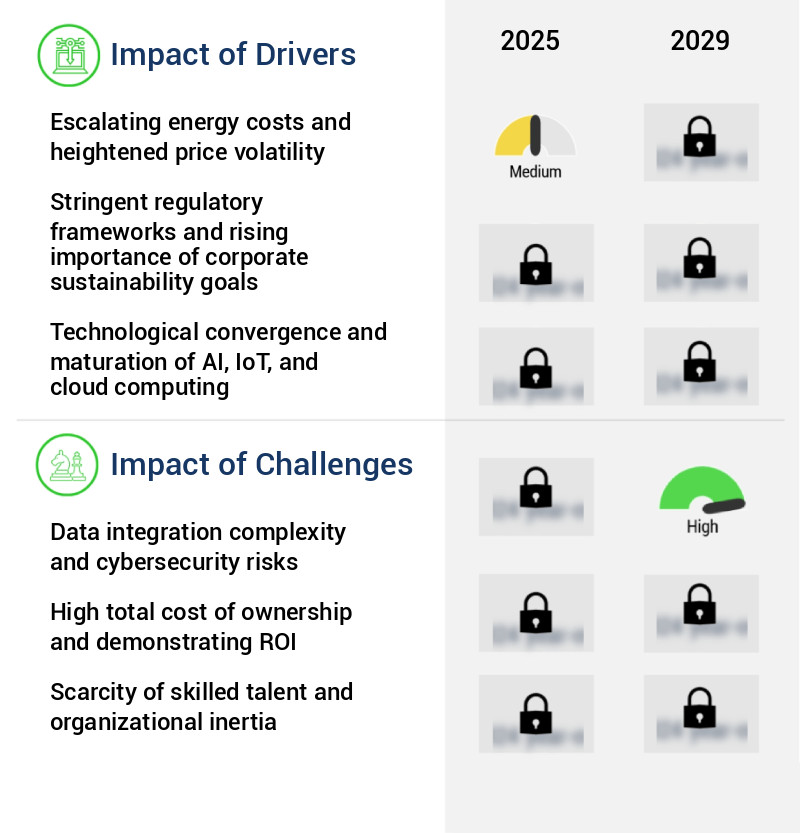
In-Depth Market Segmentation: AI Energy Efficiency Tools Market
The ai energy efficiency tools industry research report provides comprehensive data (region-wise segment analysis), with forecasts and estimates in "USD million" for the period 2025-2029, as well as historical data from 2019-2023 for the following segments.
- Component
- Deployment
- Application
- Energy management
- Smart grid management
- Predictive maintenance
- Building automation
- Geography
- North America
- Europe
- APAC
- China
- India
- Japan
- South Korea
- South America
- Rest of World (ROW)
By Component Insights
The software segment is estimated to witness significant growth during the forecast period.
The market is witnessing continuous evolution, driven by advancements in technologies such as machine learning models, cloud-based energy platforms, and predictive analytics. This software component, representing the core intelligence engine of the market, processes and analyzes vast data sets to identify energy optimization opportunities. It moves beyond reactive energy management towards a proactive and predictive model, integrating with diverse data sources like IoT sensors, building management systems, smart meters, and external feeds. Applications include peak demand reduction through energy arbitrage strategies, HVAC optimization techniques using natural language processing and deep learning, and demand-side management through sensor data analytics.
Additionally, AI-powered energy control is integrated into data center cooling, thermal energy storage, industrial energy audits, and smart metering systems. Energy efficiency algorithms are also employed in wind energy optimization, real-time energy monitoring, and distributed energy resources management. The market's innovation is further fueled by applications in geothermal energy systems, AI-powered building energy modeling, electric vehicle charging, smart grid optimization, predictive maintenance AI, renewable energy integration, carbon footprint reduction, power system simulation, solar energy forecasting, energy consumption prediction, microgrid control systems, and building automation systems. A recent study reveals that implementing AI energy efficiency tools can lead to a 15% reduction in energy consumption.
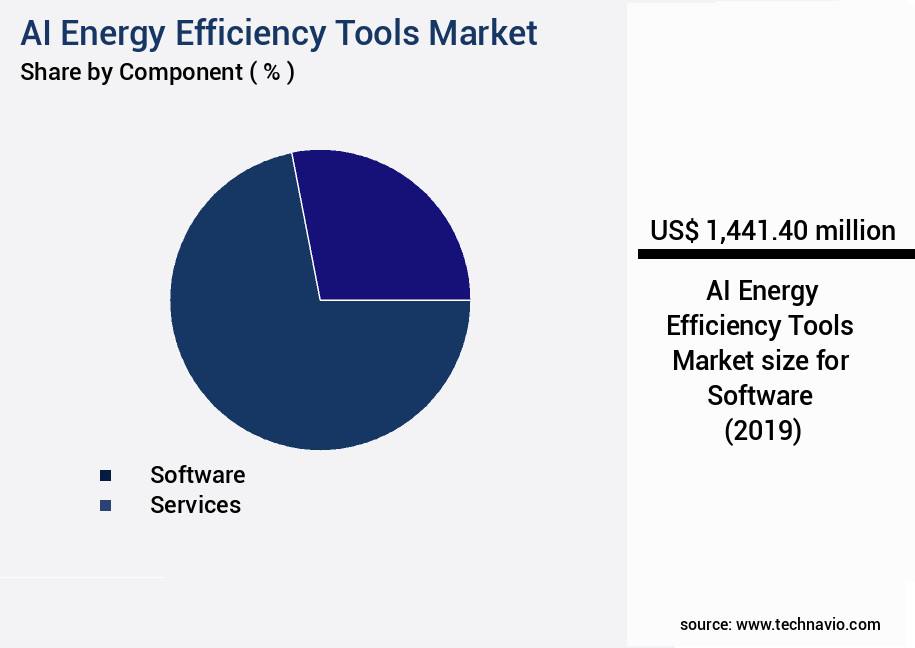
Request Free Sample
The Software segment was valued at USD 1.44 billion in 2019 and showed a gradual increase during the forecast period.
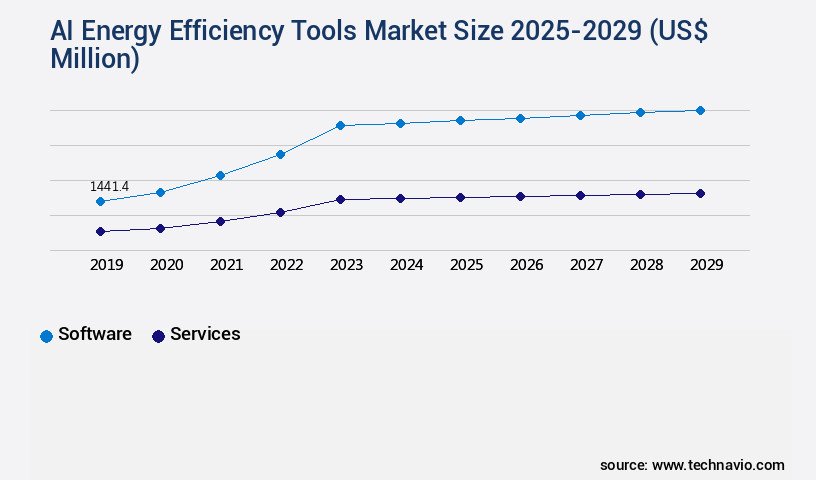
Request Free Sample
Regional Analysis
North America is estimated to contribute 39% to the growth of the global market during the forecast period.Technavio’s analysts have elaborately explained the regional trends and drivers that shape the market during the forecast period.
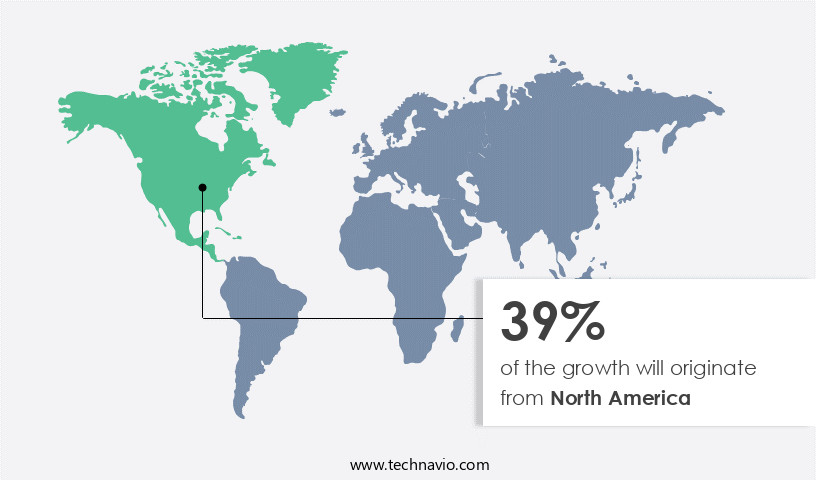
See How AI Energy Efficiency Tools Market Demand is Rising in North America Request Free Sample
The market is experiencing dynamic growth, with North America leading the charge. This region, encompassing the United States and Canada, is characterized by its advanced technological landscape, high energy costs in major economic hubs, and a strong corporate culture prioritizing operational efficiency. Key players, both established technology leaders and emerging AI startups, are capitalizing on this environment. The market's expansion is driven by a compelling economic argument to reduce substantial energy expenditure and escalating investor and consumer expectations for corporate sustainability. Government policy, such as the Inflation Reduction Act in the US, further accelerates adoption by offering substantial tax credits and incentives for energy efficiency upgrades and clean technology investments.
According to recent studies, the market for AI energy efficiency tools is projected to grow at an impressive rate, with one report estimating a 20% increase in energy savings for companies adopting these solutions. Another study reveals that AI-driven energy management systems can reduce energy consumption in commercial buildings by up to 30%. These figures underscore the significant potential for cost savings and environmental impact reduction.
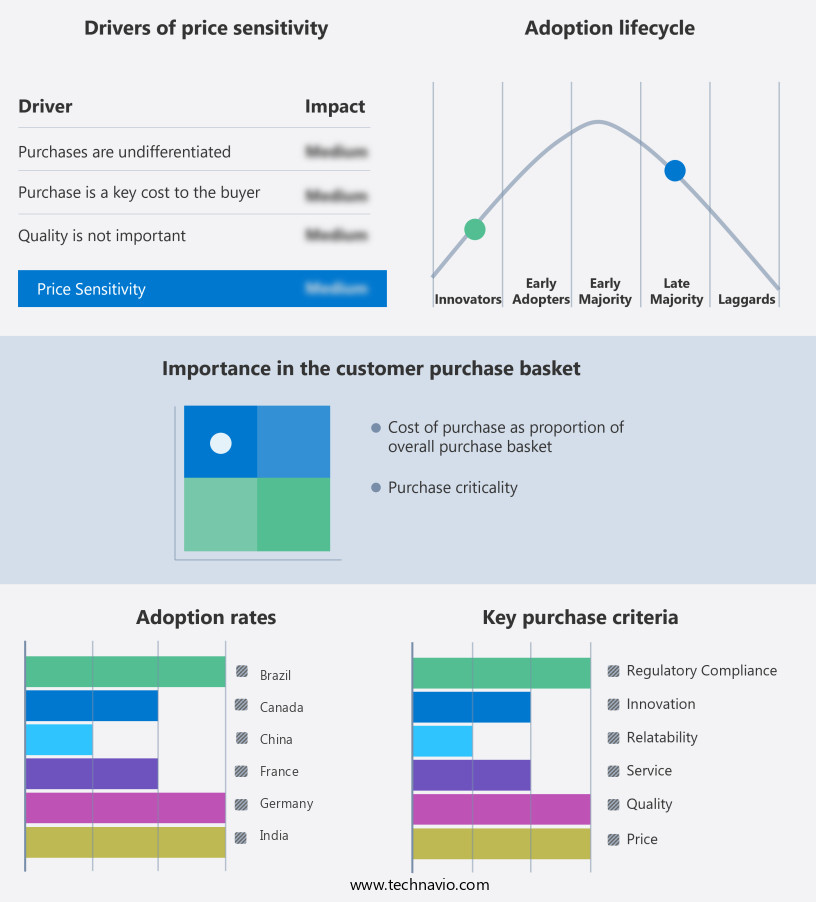
Customer Landscape of AI Energy Efficiency Tools Industry
Competitive Intelligence by Technavio Analysis: Leading Players in the AI Energy Efficiency Tools Market
Companies are implementing various strategies, such as strategic alliances, ai energy efficiency tools market forecast, partnerships, mergers and acquisitions, geographical expansion, and product/service launches, to enhance their presence in the industry.
ABB Ltd. - The company's AI energy efficiency tools, Emissium and EVA platforms, enhance grid optimization, building decarbonization, and predictive analytics within ABB's energy management ecosystem. These advanced solutions facilitate efficient energy usage and promote sustainable energy practices.
The industry research and growth report includes detailed analyses of the competitive landscape of the market and information about key companies, including:
- ABB Ltd.
- Amazon.com Inc.
- C3.ai Inc.
- Eaton Corp. plc
- Enel Spa
- General Electric Co.
- GridPoint Inc.
- Hitachi Ltd.
- Honeywell International Inc.
- Huawei Technologies Co. Ltd.
- Infosys Ltd.
- International Business Machines Corp.
- Johnson Controls International Plc
- Microsoft Corp.
- Mitsubishi Electric Corp.
- Rockwell Automation Inc.
- Schneider Electric SE
- Siemens AG
- Verdigris Technologies Inc.
Qualitative and quantitative analysis of companies has been conducted to help clients understand the wider business environment as well as the strengths and weaknesses of key industry players. Data is qualitatively analyzed to categorize companies as pure play, category-focused, industry-focused, and diversified; it is quantitatively analyzed to categorize companies as dominant, leading, strong, tentative, and weak.
Recent Development and News in AI Energy Efficiency Tools Market
- In August 2024, IBM announced the launch of its new AI-powered energy efficiency tool, "IBM Energy Manager," designed to optimize energy usage in data centers and industrial facilities. This tool uses machine learning algorithms to analyze energy consumption patterns and suggest improvements in real-time (IBM Press Release, 2024).
- In November 2024, Microsoft and Schneider Electric formed a strategic partnership to integrate Microsoft's Azure IoT and AI technologies with Schneider Electric's energy management solutions. This collaboration aims to help businesses optimize energy usage and reduce costs through predictive analytics and automation (Microsoft News Center, 2024).
- In February 2025, Siemens Gamesa Renewable Energy secured a €100 million investment from E.ON to develop AI-driven wind farm optimization solutions. This collaboration will leverage Siemens Gamesa's expertise in renewable energy and E.ON's financial backing to improve the efficiency of wind farms and reduce carbon emissions (E.ON Press Release, 2025).
- In May 2025, the European Union passed the "Energy Efficiency Directive 3.0," which mandates the use of AI and IoT technologies in energy efficiency improvements for all new and existing buildings by 2030. This regulatory push is expected to create significant demand for AI energy efficiency tools across Europe (European Commission, 2025).
Dive into Technavio’s robust research methodology, blending expert interviews, extensive data synthesis, and validated models for unparalleled AI Energy Efficiency Tools Market insights. See full methodology.
|
Market Scope
|
|
Report Coverage
|
Details
|
|
Page number
|
241
|
|
Base year
|
2024
|
|
Historic period
|
2019-2023 |
|
Forecast period
|
2025-2029
|
|
Growth momentum & CAGR
|
Accelerate at a CAGR of 34.7%
|
|
Market growth 2025-2029
|
USD 23500.2 million
|
|
Market structure
|
Fragmented
|
|
YoY growth 2024-2025(%)
|
32.7
|
|
Key countries
|
US, China, Germany, India, Canada, UK, Japan, France, Brazil, and South Korea
|
|
Competitive landscape
|
Leading Companies, Market Positioning of Companies, Competitive Strategies, and Industry Risks
|
Request Free Sample
Why Choose Technavio for AI Energy Efficiency Tools Market Insights?
"Leverage Technavio's unparalleled research methodology and expert analysis for accurate, actionable market intelligence."
The market is experiencing significant growth as businesses and organizations seek to optimize energy usage and reduce their carbon footprint. One of the key applications of AI in this space is the predictive modeling of energy use, which enables businesses to anticipate demand and adjust energy consumption accordingly. This can lead to substantial savings, particularly during peak demand periods.
Another area where AI is making a significant impact is in the optimization of HVAC systems. By leveraging AI algorithms for energy efficiency, businesses can fine-tune their heating and cooling systems to achieve optimal performance. Real-time data analytics for energy management also play a crucial role, allowing businesses to monitor energy usage and identify areas for improvement in real-time.
The implementation of smart grid technologies is another major trend in the market. Machine learning algorithms are being used to improve renewable energy integration, ensuring a stable power supply while minimizing waste. AI-driven energy storage optimization is also becoming increasingly important, allowing businesses to store excess energy and use it during peak demand periods.
Data-driven decision support for energy management is a key business function that is being enhanced by AI. Advanced analytics for building energy management, for example, can help businesses identify patterns in energy usage and optimize their operations accordingly. AI applications for industrial energy optimization are also gaining popularity, enabling manufacturers to reduce energy consumption and improve operational efficiency.
Compared to traditional energy management methods, AI-powered energy solutions offer significant advantages. For instance, a study by the International Energy Agency found that AI can help reduce peak electricity demand by up to 15%, leading to substantial cost savings for businesses. Furthermore, AI-based solutions for energy conservation can help businesses reduce their carbon footprint by up to 30%, making them an attractive option for companies looking to meet sustainability targets.
In conclusion, the market is poised for significant growth as businesses seek to optimize energy usage and reduce their carbon footprint. By leveraging AI algorithms for energy efficiency, predictive modeling of energy use, optimization of HVAC systems, real-time data analytics for energy management, and advanced analytics for building energy management, businesses can achieve substantial energy savings and operational efficiencies.
What are the Key Data Covered in this AI Energy Efficiency Tools Market Research and Growth Report?
-
What is the expected growth of the AI Energy Efficiency Tools Market between 2025 and 2029?
-
What segmentation does the market report cover?
-
The report is segmented by Component (Software and Services), Deployment (Cloud-based and On-premises), Application (Energy management, Smart grid management, Predictive maintenance, and Building automation), and Geography (North America, APAC, Europe, South America, and Middle East and Africa)
-
Which regions are analyzed in the report?
-
North America, APAC, Europe, South America, and Middle East and Africa
-
What are the key growth drivers and market challenges?
-
Who are the major players in the AI Energy Efficiency Tools Market?
-
ABB Ltd., Amazon.com Inc., C3.ai Inc., Eaton Corp. plc, Enel Spa, General Electric Co., GridPoint Inc., Hitachi Ltd., Honeywell International Inc., Huawei Technologies Co. Ltd., Infosys Ltd., International Business Machines Corp., Johnson Controls International Plc, Microsoft Corp., Mitsubishi Electric Corp., Rockwell Automation Inc., Schneider Electric SE, Siemens AG, and Verdigris Technologies Inc.
We can help! Our analysts can customize this ai energy efficiency tools market research report to meet your requirements.
Get in touch
1 Executive Summary
- 1.1 Market overview
- Executive Summary - Chart on Market Overview
- Executive Summary - Data Table on Market Overview
- Executive Summary - Chart on Global Market Characteristics
- Executive Summary - Chart on Market by Geography
- Executive Summary - Chart on Market Segmentation by Component
- Executive Summary - Chart on Market Segmentation by Deployment
- Executive Summary - Chart on Market Segmentation by Application
- Executive Summary - Chart on Incremental Growth
- Executive Summary - Data Table on Incremental Growth
- Executive Summary - Chart on Company Market Positioning
2 Technavio Analysis
- 2.1 Analysis of price sensitivity, lifecycle, customer purchase basket, adoption rates, and purchase criteria
- Analysis of price sensitivity, lifecycle, customer purchase basket, adoption rates, and purchase criteria
- 2.2 Criticality of inputs and Factors of differentiation
- Overview on criticality of inputs and factors of differentiation
- 2.3 Factors of disruption
- Overview on factors of disruption
- 2.4 Impact of drivers and challenges
- Impact of drivers and challenges in 2024 and 2029
3 Market Landscape
- 3.1 Market ecosystem
- Parent Market
- Data Table on - Parent Market
- 3.2 Market characteristics
- Market characteristics analysis
4 Market Sizing
- 4.1 Market definition
- Offerings of companies included in the market definition
- 4.2 Market segment analysis
- 4.4 Market outlook: Forecast for 2024-2029
- Chart on Global - Market size and forecast 2024-2029 ($ million)
- Data Table on Global - Market size and forecast 2024-2029 ($ million)
- Chart on Global Market: Year-over-year growth 2024-2029 (%)
- Data Table on Global Market: Year-over-year growth 2024-2029 (%)
5 Historic Market Size
- 5.1 Global AI Energy Efficiency Tools Market 2019 - 2023
- Historic Market Size - Data Table on Global AI Energy Efficiency Tools Market 2019 - 2023 ($ million)
- 5.2 Component segment analysis 2019 - 2023
- Historic Market Size - Component Segment 2019 - 2023 ($ million)
- 5.3 Deployment segment analysis 2019 - 2023
- Historic Market Size - Deployment Segment 2019 - 2023 ($ million)
- 5.4 Application segment analysis 2019 - 2023
- Historic Market Size - Application Segment 2019 - 2023 ($ million)
- 5.5 Geography segment analysis 2019 - 2023
- Historic Market Size - Geography Segment 2019 - 2023 ($ million)
- 5.6 Country segment analysis 2019 - 2023
- Historic Market Size - Country Segment 2019 - 2023 ($ million)
6 Five Forces Analysis
- 6.1 Five forces summary
- Five forces analysis - Comparison between 2024 and 2029
- 6.2 Bargaining power of buyers
- Bargaining power of buyers - Impact of key factors 2024 and 2029
- 6.3 Bargaining power of suppliers
- Bargaining power of suppliers - Impact of key factors in 2024 and 2029
- 6.4 Threat of new entrants
- Threat of new entrants - Impact of key factors in 2024 and 2029
- 6.5 Threat of substitutes
- Threat of substitutes - Impact of key factors in 2024 and 2029
- 6.6 Threat of rivalry
- Threat of rivalry - Impact of key factors in 2024 and 2029
- 6.7 Market condition
- Chart on Market condition - Five forces 2024 and 2029
7 Market Segmentation by Component
- 7.1 Market segments
- Chart on Component - Market share 2024-2029 (%)
- Data Table on Component - Market share 2024-2029 (%)
- 7.2 Comparison by Component
- Chart on Comparison by Component
- Data Table on Comparison by Component
- 7.3 Software - Market size and forecast 2024-2029
- Chart on Software - Market size and forecast 2024-2029 ($ million)
- Data Table on Software - Market size and forecast 2024-2029 ($ million)
- Chart on Software - Year-over-year growth 2024-2029 (%)
- Data Table on Software - Year-over-year growth 2024-2029 (%)
- 7.4 Services - Market size and forecast 2024-2029
- Chart on Services - Market size and forecast 2024-2029 ($ million)
- Data Table on Services - Market size and forecast 2024-2029 ($ million)
- Chart on Services - Year-over-year growth 2024-2029 (%)
- Data Table on Services - Year-over-year growth 2024-2029 (%)
- 7.5 Market opportunity by Component
- Market opportunity by Component ($ million)
- Data Table on Market opportunity by Component ($ million)
8 Market Segmentation by Deployment
- 8.1 Market segments
- Chart on Deployment - Market share 2024-2029 (%)
- Data Table on Deployment - Market share 2024-2029 (%)
- 8.2 Comparison by Deployment
- Chart on Comparison by Deployment
- Data Table on Comparison by Deployment
- 8.3 Cloud-based - Market size and forecast 2024-2029
- Chart on Cloud-based - Market size and forecast 2024-2029 ($ million)
- Data Table on Cloud-based - Market size and forecast 2024-2029 ($ million)
- Chart on Cloud-based - Year-over-year growth 2024-2029 (%)
- Data Table on Cloud-based - Year-over-year growth 2024-2029 (%)
- 8.4 On-premises - Market size and forecast 2024-2029
- Chart on On-premises - Market size and forecast 2024-2029 ($ million)
- Data Table on On-premises - Market size and forecast 2024-2029 ($ million)
- Chart on On-premises - Year-over-year growth 2024-2029 (%)
- Data Table on On-premises - Year-over-year growth 2024-2029 (%)
- 8.5 Market opportunity by Deployment
- Market opportunity by Deployment ($ million)
- Data Table on Market opportunity by Deployment ($ million)
9 Market Segmentation by Application
- 9.1 Market segments
- Chart on Application - Market share 2024-2029 (%)
- Data Table on Application - Market share 2024-2029 (%)
- 9.2 Comparison by Application
- Chart on Comparison by Application
- Data Table on Comparison by Application
- 9.3 Energy management - Market size and forecast 2024-2029
- Chart on Energy management - Market size and forecast 2024-2029 ($ million)
- Data Table on Energy management - Market size and forecast 2024-2029 ($ million)
- Chart on Energy management - Year-over-year growth 2024-2029 (%)
- Data Table on Energy management - Year-over-year growth 2024-2029 (%)
- 9.4 Smart grid management - Market size and forecast 2024-2029
- Chart on Smart grid management - Market size and forecast 2024-2029 ($ million)
- Data Table on Smart grid management - Market size and forecast 2024-2029 ($ million)
- Chart on Smart grid management - Year-over-year growth 2024-2029 (%)
- Data Table on Smart grid management - Year-over-year growth 2024-2029 (%)
- 9.5 Predictive maintenance - Market size and forecast 2024-2029
- Chart on Predictive maintenance - Market size and forecast 2024-2029 ($ million)
- Data Table on Predictive maintenance - Market size and forecast 2024-2029 ($ million)
- Chart on Predictive maintenance - Year-over-year growth 2024-2029 (%)
- Data Table on Predictive maintenance - Year-over-year growth 2024-2029 (%)
- 9.6 Building automation - Market size and forecast 2024-2029
- Chart on Building automation - Market size and forecast 2024-2029 ($ million)
- Data Table on Building automation - Market size and forecast 2024-2029 ($ million)
- Chart on Building automation - Year-over-year growth 2024-2029 (%)
- Data Table on Building automation - Year-over-year growth 2024-2029 (%)
- 9.7 Market opportunity by Application
- Market opportunity by Application ($ million)
- Data Table on Market opportunity by Application ($ million)
10 Customer Landscape
- 10.1 Customer landscape overview
- Analysis of price sensitivity, lifecycle, customer purchase basket, adoption rates, and purchase criteria
11 Geographic Landscape
- 11.1 Geographic segmentation
- Chart on Market share by geography 2024-2029 (%)
- Data Table on Market share by geography 2024-2029 (%)
- 11.2 Geographic comparison
- Chart on Geographic comparison
- Data Table on Geographic comparison
- 11.3 North America - Market size and forecast 2024-2029
- Chart on North America - Market size and forecast 2024-2029 ($ million)
- Data Table on North America - Market size and forecast 2024-2029 ($ million)
- Chart on North America - Year-over-year growth 2024-2029 (%)
- Data Table on North America - Year-over-year growth 2024-2029 (%)
- 11.4 APAC - Market size and forecast 2024-2029
- Chart on APAC - Market size and forecast 2024-2029 ($ million)
- Data Table on APAC - Market size and forecast 2024-2029 ($ million)
- Chart on APAC - Year-over-year growth 2024-2029 (%)
- Data Table on APAC - Year-over-year growth 2024-2029 (%)
- 11.5 Europe - Market size and forecast 2024-2029
- Chart on Europe - Market size and forecast 2024-2029 ($ million)
- Data Table on Europe - Market size and forecast 2024-2029 ($ million)
- Chart on Europe - Year-over-year growth 2024-2029 (%)
- Data Table on Europe - Year-over-year growth 2024-2029 (%)
- 11.6 South America - Market size and forecast 2024-2029
- Chart on South America - Market size and forecast 2024-2029 ($ million)
- Data Table on South America - Market size and forecast 2024-2029 ($ million)
- Chart on South America - Year-over-year growth 2024-2029 (%)
- Data Table on South America - Year-over-year growth 2024-2029 (%)
- 11.7 Middle East and Africa - Market size and forecast 2024-2029
- Chart on Middle East and Africa - Market size and forecast 2024-2029 ($ million)
- Data Table on Middle East and Africa - Market size and forecast 2024-2029 ($ million)
- Chart on Middle East and Africa - Year-over-year growth 2024-2029 (%)
- Data Table on Middle East and Africa - Year-over-year growth 2024-2029 (%)
- 11.8 US - Market size and forecast 2024-2029
- Chart on US - Market size and forecast 2024-2029 ($ million)
- Data Table on US - Market size and forecast 2024-2029 ($ million)
- Chart on US - Year-over-year growth 2024-2029 (%)
- Data Table on US - Year-over-year growth 2024-2029 (%)
- 11.9 China - Market size and forecast 2024-2029
- Chart on China - Market size and forecast 2024-2029 ($ million)
- Data Table on China - Market size and forecast 2024-2029 ($ million)
- Chart on China - Year-over-year growth 2024-2029 (%)
- Data Table on China - Year-over-year growth 2024-2029 (%)
- 11.10 Germany - Market size and forecast 2024-2029
- Chart on Germany - Market size and forecast 2024-2029 ($ million)
- Data Table on Germany - Market size and forecast 2024-2029 ($ million)
- Chart on Germany - Year-over-year growth 2024-2029 (%)
- Data Table on Germany - Year-over-year growth 2024-2029 (%)
- 11.11 India - Market size and forecast 2024-2029
- Chart on India - Market size and forecast 2024-2029 ($ million)
- Data Table on India - Market size and forecast 2024-2029 ($ million)
- Chart on India - Year-over-year growth 2024-2029 (%)
- Data Table on India - Year-over-year growth 2024-2029 (%)
- 11.12 UK - Market size and forecast 2024-2029
- Chart on UK - Market size and forecast 2024-2029 ($ million)
- Data Table on UK - Market size and forecast 2024-2029 ($ million)
- Chart on UK - Year-over-year growth 2024-2029 (%)
- Data Table on UK - Year-over-year growth 2024-2029 (%)
- 11.13 Canada - Market size and forecast 2024-2029
- Chart on Canada - Market size and forecast 2024-2029 ($ million)
- Data Table on Canada - Market size and forecast 2024-2029 ($ million)
- Chart on Canada - Year-over-year growth 2024-2029 (%)
- Data Table on Canada - Year-over-year growth 2024-2029 (%)
- 11.14 Japan - Market size and forecast 2024-2029
- Chart on Japan - Market size and forecast 2024-2029 ($ million)
- Data Table on Japan - Market size and forecast 2024-2029 ($ million)
- Chart on Japan - Year-over-year growth 2024-2029 (%)
- Data Table on Japan - Year-over-year growth 2024-2029 (%)
- 11.15 France - Market size and forecast 2024-2029
- Chart on France - Market size and forecast 2024-2029 ($ million)
- Data Table on France - Market size and forecast 2024-2029 ($ million)
- Chart on France - Year-over-year growth 2024-2029 (%)
- Data Table on France - Year-over-year growth 2024-2029 (%)
- 11.16 Brazil - Market size and forecast 2024-2029
- Chart on Brazil - Market size and forecast 2024-2029 ($ million)
- Data Table on Brazil - Market size and forecast 2024-2029 ($ million)
- Chart on Brazil - Year-over-year growth 2024-2029 (%)
- Data Table on Brazil - Year-over-year growth 2024-2029 (%)
- 11.17 South Korea - Market size and forecast 2024-2029
- Chart on South Korea - Market size and forecast 2024-2029 ($ million)
- Data Table on South Korea - Market size and forecast 2024-2029 ($ million)
- Chart on South Korea - Year-over-year growth 2024-2029 (%)
- Data Table on South Korea - Year-over-year growth 2024-2029 (%)
- 11.18 Market opportunity by geography
- Market opportunity by geography ($ million)
- Data Tables on Market opportunity by geography ($ million)
12 Drivers, Challenges, and Opportunity/Restraints
- 12.3 Impact of drivers and challenges
- Impact of drivers and challenges in 2024 and 2029
- 12.4 Market opportunities/restraints
13 Competitive Landscape
- 13.2 Competitive Landscape
- Overview on criticality of inputs and factors of differentiation
- 13.3 Landscape disruption
- Overview on factors of disruption
- 13.4 Industry risks
- Impact of key risks on business
14 Competitive Analysis
- 14.2 Company ranking index
- 14.3 Market positioning of companies
- Matrix on companies position and classification
- 14.4 ABB Ltd.
- ABB Ltd. - Overview
- ABB Ltd. - Business segments
- ABB Ltd. - Key news
- ABB Ltd. - Key offerings
- ABB Ltd. - Segment focus
- SWOT
- 14.5 Amazon.com Inc.
- Amazon.com Inc. - Overview
- Amazon.com Inc. - Business segments
- Amazon.com Inc. - Key news
- Amazon.com Inc. - Key offerings
- Amazon.com Inc. - Segment focus
- SWOT
- 14.6 C3.ai Inc.
- C3.ai Inc. - Overview
- C3.ai Inc. - Product / Service
- C3.ai Inc. - Key news
- C3.ai Inc. - Key offerings
- SWOT
- 14.7 Eaton Corp. plc
- Eaton Corp. plc - Overview
- Eaton Corp. plc - Business segments
- Eaton Corp. plc - Key news
- Eaton Corp. plc - Key offerings
- Eaton Corp. plc - Segment focus
- SWOT
- 14.8 General Electric Co.
- General Electric Co. - Overview
- General Electric Co. - Business segments
- General Electric Co. - Key news
- General Electric Co. - Key offerings
- General Electric Co. - Segment focus
- SWOT
- 14.9 Hitachi Ltd.
- Hitachi Ltd. - Overview
- Hitachi Ltd. - Business segments
- Hitachi Ltd. - Key news
- Hitachi Ltd. - Key offerings
- Hitachi Ltd. - Segment focus
- SWOT
- 14.10 Honeywell International Inc.
- Honeywell International Inc. - Overview
- Honeywell International Inc. - Business segments
- Honeywell International Inc. - Key news
- Honeywell International Inc. - Key offerings
- Honeywell International Inc. - Segment focus
- SWOT
- 14.11 Infosys Ltd.
- Infosys Ltd. - Overview
- Infosys Ltd. - Business segments
- Infosys Ltd. - Key news
- Infosys Ltd. - Key offerings
- Infosys Ltd. - Segment focus
- SWOT
- 14.12 International Business Machines Corp.
- International Business Machines Corp. - Overview
- International Business Machines Corp. - Business segments
- International Business Machines Corp. - Key news
- International Business Machines Corp. - Key offerings
- International Business Machines Corp. - Segment focus
- SWOT
- 14.13 Johnson Controls International Plc
- Johnson Controls International Plc - Overview
- Johnson Controls International Plc - Business segments
- Johnson Controls International Plc - Key news
- Johnson Controls International Plc - Key offerings
- Johnson Controls International Plc - Segment focus
- SWOT
- 14.14 Microsoft Corp.
- Microsoft Corp. - Overview
- Microsoft Corp. - Business segments
- Microsoft Corp. - Key news
- Microsoft Corp. - Key offerings
- Microsoft Corp. - Segment focus
- SWOT
- 14.15 Mitsubishi Electric Corp.
- Mitsubishi Electric Corp. - Overview
- Mitsubishi Electric Corp. - Business segments
- Mitsubishi Electric Corp. - Key offerings
- Mitsubishi Electric Corp. - Segment focus
- SWOT
- 14.16 Rockwell Automation Inc.
- Rockwell Automation Inc. - Overview
- Rockwell Automation Inc. - Business segments
- Rockwell Automation Inc. - Key news
- Rockwell Automation Inc. - Key offerings
- Rockwell Automation Inc. - Segment focus
- SWOT
- 14.17 Schneider Electric SE
- Schneider Electric SE - Overview
- Schneider Electric SE - Business segments
- Schneider Electric SE - Key news
- Schneider Electric SE - Key offerings
- Schneider Electric SE - Segment focus
- SWOT
- 14.18 Siemens AG
- Siemens AG - Overview
- Siemens AG - Business segments
- Siemens AG - Key news
- Siemens AG - Key offerings
- Siemens AG - Segment focus
- SWOT
15 Appendix
- 15.2 Inclusions and exclusions checklist
- Inclusions checklist
- Exclusions checklist
- 15.3 Currency conversion rates for US$
- Currency conversion rates for US$
- 15.4 Research methodology
- 15.7 Validation techniques employed for market sizing
- Validation techniques employed for market sizing
- 15.9 360 degree market analysis
- 360 degree market analysis
- 15.10 List of abbreviations







![]() Get the report (PDF) sent to your email within minutes.
Get the report (PDF) sent to your email within minutes.
Complimentary full Excel data with your report purchase.